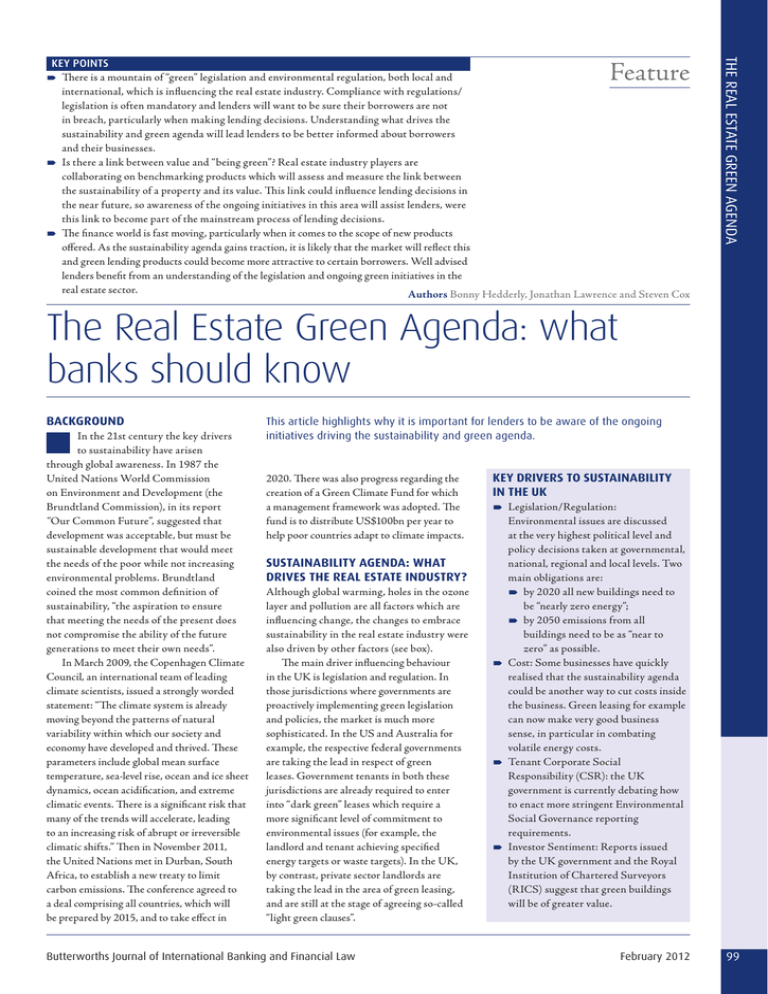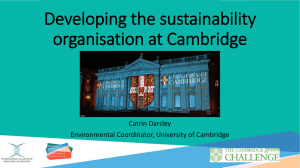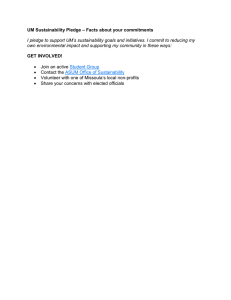The Real Estate Green Agenda: what banks should know Feature THE RE
advertisement

THE REAL ESTATE GREEN AGENDA Feature KEY POINTS There is a mountain of “green” legislation and environmental regulation, both local and international, which is influencing the real estate industry. Compliance with regulations/ legislation is often mandatory and lenders will want to be sure their borrowers are not in breach, particularly when making lending decisions. Understanding what drives the sustainability and green agenda will lead lenders to be better informed about borrowers and their businesses. Is there a link between value and “being green”? Real estate industry players are collaborating on benchmarking products which will assess and measure the link between the sustainability of a property and its value. This link could influence lending decisions in the near future, so awareness of the ongoing initiatives in this area will assist lenders, were this link to become part of the mainstream process of lending decisions. The finance world is fast moving, particularly when it comes to the scope of new products offered. As the sustainability agenda gains traction, it is likely that the market will reflect this and green lending products could become more attractive to certain borrowers. Well advised lenders benefit from an understanding of the legislation and ongoing green initiatives in the real estate sector. Authors Bonny Hedderly, Jonathan Lawrence and Steven Cox The Real Estate Green Agenda: what banks should know BACKGROUND In the 21st century the key drivers to sustainability have arisen through global awareness. In 1987 the United Nations World Commission on Environment and Development (the Brundtland Commission), in its report “Our Common Future”, suggested that development was acceptable, but must be sustainable development that would meet the needs of the poor while not increasing environmental problems. Brundtland coined the most common definition of sustainability, “the aspiration to ensure that meeting the needs of the present does not compromise the ability of the future generations to meet their own needs”. In March 2009, the Copenhagen Climate Council, an international team of leading climate scientists, issued a strongly worded statement: “The climate system is already moving beyond the patterns of natural variability within which our society and economy have developed and thrived. These parameters include global mean surface temperature, sea-level rise, ocean and ice sheet dynamics, ocean acidification, and extreme climatic events. There is a significant risk that many of the trends will accelerate, leading to an increasing risk of abrupt or irreversible climatic shifts.” Then in November 2011, the United Nations met in Durban, South Africa, to establish a new treaty to limit carbon emissions. The conference agreed to a deal comprising all countries, which will be prepared by 2015, and to take effect in This article highlights why it is important for lenders to be aware of the ongoing initiatives driving the sustainability and green agenda. 2020. There was also progress regarding the creation of a Green Climate Fund for which a management framework was adopted. The fund is to distribute US$100bn per year to help poor countries adapt to climate impacts. SUSTAINABILITY AGENDA: WHAT DRIVES THE REAL ESTATE INDUSTRY? Although global warming, holes in the ozone layer and pollution are all factors which are influencing change, the changes to embrace sustainability in the real estate industry were also driven by other factors (see box). The main driver influencing behaviour in the UK is legislation and regulation. In those jurisdictions where governments are proactively implementing green legislation and policies, the market is much more sophisticated. In the US and Australia for example, the respective federal governments are taking the lead in respect of green leases. Government tenants in both these jurisdictions are already required to enter into “dark green” leases which require a more significant level of commitment to environmental issues (for example, the landlord and tenant achieving specified energy targets or waste targets). In the UK, by contrast, private sector landlords are taking the lead in the area of green leasing, and are still at the stage of agreeing so-called “light green clauses”. Butterworths Journal of International Banking and Financial Law KEY DRIVERS TO SUSTAINABILITY IN THE UK Legislation/Regulation: Environmental issues are discussed at the very highest political level and policy decisions taken at governmental, national, regional and local levels. Two main obligations are: by 2020 all new buildings need to be “nearly zero energy”; by 2050 emissions from all buildings need to be as “near to zero” as possible. Cost: Some businesses have quickly realised that the sustainability agenda could be another way to cut costs inside the business. Green leasing for example can now make very good business sense, in particular in combating volatile energy costs. Tenant Corporate Social Responsibility (CSR): the UK government is currently debating how to enact more stringent Environmental Social Governance reporting requirements. Investor Sentiment: Reports issued by the UK government and the Royal Institution of Chartered Surveyors (RICS) suggest that green buildings will be of greater value. February 2012 99 THE REAL ESTATE GREEN AGENDA Feature Investment Funds: An issue that is much debated at present is how investment funds should view green issues given that they have fiduciary duties to their investors when making investment decisions. The sense is that, for a variety of reasons, green buildings should prove to be good investments. UK LEGISLATIVE LANDSCAPE The UK Energy Act received Royal Assent on 18 October 2011. One of its objectives is to encourage investment in energy efficiency measures for homes and commercial real estate. Most of the legislation impacting the building sector comes through Directives, such as the Energy Performance of Buildings Directive (EPBD). In May 2010, the existing EPBD evolved to strengthen the building energy performance requirements. The revised Directive needs to be transposed into national legislation by the EU member states (including the UK) by July 2012. Other measures to encourage greener and more energy-efficient commercial buildings include: Government planning policies: The Planning Policy Statement on Climate Change requires local authorities to provide a policy framework promoting renewable and low-carbon energy generation. Local planning policies: Local planning authorities have some discretion in the level of green or energy efficiency standards they require from new buildings in their area. London-wide regional policy sets particularly high standards. A LINK BETWEEN SUSTAINABILITY AND PROPERTY VALUES? The real estate industry is both out of necessity and sentiment starting to embrace sustainability issues – however, although it has been much debated, it is not yet clear whether there is any direct link between how sustainable a property is and its value. The sense is that green buildings are likely to be better investments for a number of reasons, 100 February 2012 Biog box Bonny Hedderly is a senior associate in the real estate group at K&L Gates and is a member of the firm's European Real Estate Sustainability Team. Email: bonny.hedderly@klgates.com Jonathan Lawrence is a partner in the finance group at K&L Gates. His practice includes international real estate finance and project finance. Email: jonathan.lawrence@klgates.com Steven Cox is Of Counsel at K&L Gates and a member of the European Real Estate Sustainability Team. Email: steven.cox@klgates.com such as: (i) combating risks such as volatile energy prices and therefore being more cost effective to run; (ii) increasing tenant retention through lower service charges; and (iii) attracting tenants with a strong CSR policy. Yet the real estate industry is still in the early stages of proving a direct link between sustainability and value. There are some initiatives which are aiming to do this and could ultimately lead to the establishment of a product, in the form of a property index, which would show the link between a single property and its value, eventually to include a whole portfolio analysis. This type of index may well be of real interest to those in the financial sector. Investors and lenders will be able to see evidence of a direct link and ultimately use that information when making investment or lending decisions. The Investment Property Databank (IPD), sponsored by the Investment Property Forum (IPF), CBRE, and K&L Gates, has produced a product known as the ISPI Monitor (IPD Sustainable Property Index Monitor), which aims to directly establish and measure the link between the sustainability credentials of a property and its value. Given the significant impact that buildings have on the environment, linking the environmental performance of property to its investment performance is an important initiative. It helps to identify whether more sustainable properties achieve the potential benefits of better rental growth, reduced risk premia, less obsolescence, shorter interruptions to cash flow and so on. The Investment Property Databank is already a leader in commercial property indices and performance analysis for the owners, investors, managers and occupiers of real estate. The ISPI Monitor has a databank of over 1,200 properties from over 100 portfolios, worth £23.1bn (as at March 2011), divided according to their adherence to quantifiable sustainability metrics. They comprise: building accessibility; building quality; energy efficiency; waste; water; and flood risk. Wherever possible, the framework draws on existing environmental tools such as IPD EcoLedger, BREEAM, Environment Agency data and Energy Performance Certificates to measure these criteria. Contributors of properties to the Monitor include some of the major real estate industry funds such as Henderson Global Investors, ING Real Estate Management, F&C REIT Asset Management plc and Prudential Property Investment Managers. Understanding and measuring the relationship between sustainability and investment performance is a critical priority for the real estate industry. As occupiers increasingly factor sustainability metrics into their decision, a clearer performance division between more and less sustainable properties will emerge. ISPI will capture that performance differential as practices in this area mature. In addition RICS has also been working with the IPD on this initiative. Sustainability is not yet priced into commercial property valuations but when it is, the ISPI Monitor should show sustainability impacts on returns, which will be of interest to the property industry as a whole and lenders will want to understand it too. WHAT DO LENDERS NEED TO KNOW? Staying up to date and being aware of some of the important green initiatives, regulations and legislation directly impacting their borrowers should keep banks in the green loop. Bankers will interact with the real estate industry and will be involved in financing green projects, which are environmentally friendly and comply with the stricter legislative framework. While the UK is not as sophisticated as jurisdictions such as Australia, where the world’s greenest building (The Pixel Building) is located, the UK is nonetheless already embracing sustainability: buildings such as Land Securities’ One New Change in the City are a good example of “green real estate”. Since the banking industry is a vital institution in global economic and business activity, bankers cannot afford to ignore sustainability. CONCLUSION This overview explains and provides a snapshot of some of the key issues and issues likely to be of most relevance to banks. The globalisation of real estate, together with the continued drive to cut carbon emissions, is likely to mean that awareness of the benefits, financial or otherwise, of “being green” will increase. That awareness could then perhaps ultimately translate to offering “green banking products” to those borrowers who require them. n Butterworths Journal of International Banking and Financial Law



